2015 NISSAN LEAF display
[x] Cancel search: displayPage 247 of 412

AUTOMATIC CLIMATE CONTROL
(MODELS WITH NAVIGATION
SYSTEM)
1. Temperature control button
2. HEAT button
3. Climate Ctrl. Timer indicator4.
(front defroster) button
5.
(fan speed control) button
6.
(rear window defroster) button (See
“Rear window and outside mirror defroster
switch” in the “Instruments and controls”
section.)
7.
(intake air control) button 8. A/C-Heater ON·OFF button
9. AUTO climate control ON button
10. MODE (manual air flow control) button
11. A/C (air conditioner) ON·OFF button
Automatic operation (AUTO)
The AUTO mode may be used year-round as the
system automatically controls constant tempera-
ture, air flow distribution and fan speed.
To turn off the climate control, press the A/C-
Heater ON·OFF button.
The same operating mode (Heater or A/C) that
was active when the system is turned off is active
when system is turned back on.
While operating the climate control in the AUTO
mode, selecting any other climate control button
de-activates the AUTO mode and activates
manual mode.
Cooling and/or dehumidified heating:
The dehumidified heating mode can be used to
keep the windows from fogging. In this mode, the
heat pump compressor is used in A/C mode for
dehumidifying the air instead of heating it. The
PTC heater is also used in conjunction to heat the
air. This mode will increase energy consumption
and therefore reduce range.
4-20Display screen, heater, air conditioner, audio and phone systems
Page 248 of 412
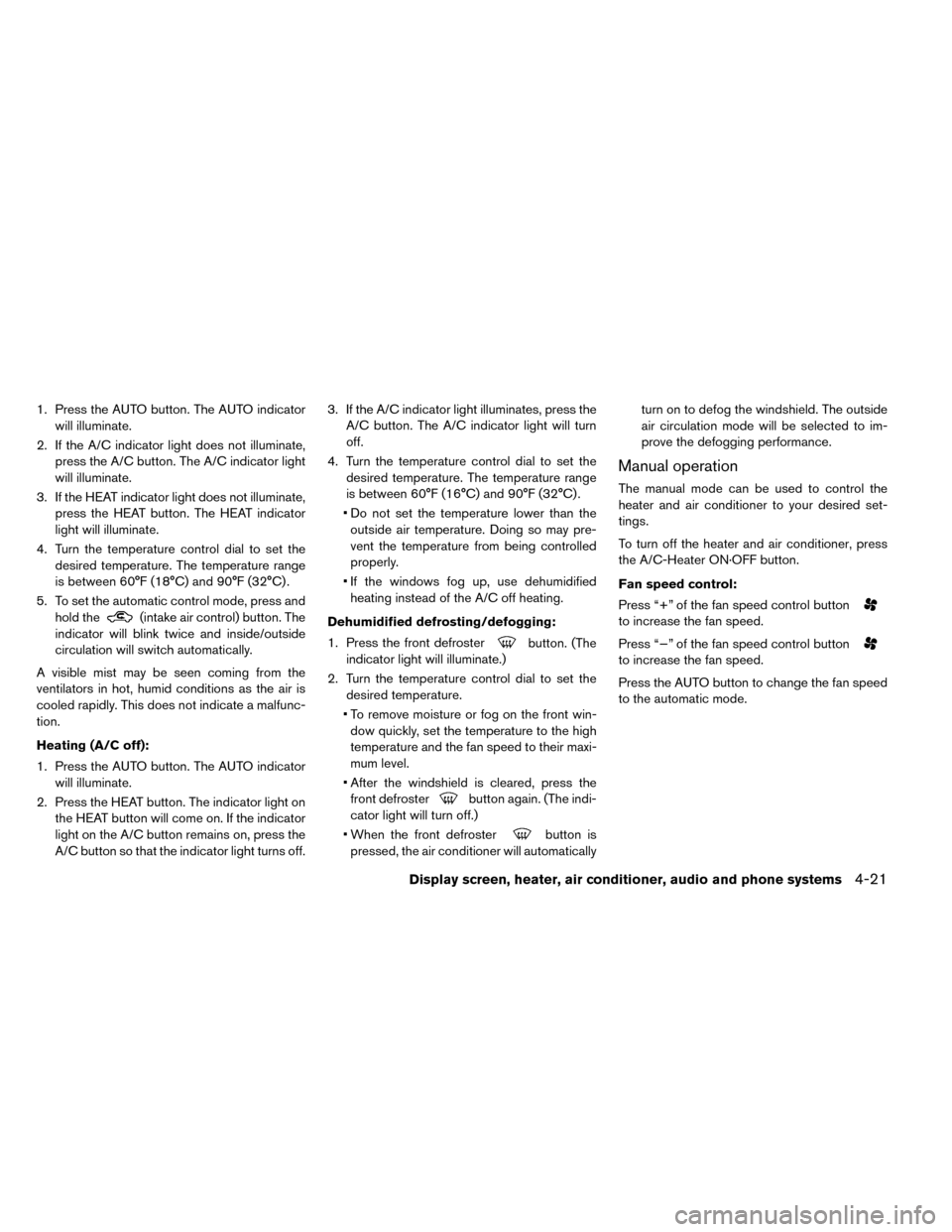
1. Press the AUTO button. The AUTO indicatorwill illuminate.
2. If the A/C indicator light does not illuminate, press the A/C button. The A/C indicator light
will illuminate.
3. If the HEAT indicator light does not illuminate, press the HEAT button. The HEAT indicator
light will illuminate.
4. Turn the temperature control dial to set the desired temperature. The temperature range
is between 60°F (18°C) and 90°F (32°C) .
5. To set the automatic control mode, press and hold the
(intake air control) button. The
indicator will blink twice and inside/outside
circulation will switch automatically.
A visible mist may be seen coming from the
ventilators in hot, humid conditions as the air is
cooled rapidly. This does not indicate a malfunc-
tion.
Heating (A/C off):
1. Press the AUTO button. The AUTO indicator will illuminate.
2. Press the HEAT button. The indicator light on the HEAT button will come on. If the indicator
light on the A/C button remains on, press the
A/C button so that the indicator light turns off. 3. If the A/C indicator light illuminates, press the
A/C button. The A/C indicator light will turn
off.
4. Turn the temperature control dial to set the desired temperature. The temperature range
is between 60°F (16°C) and 90°F (32°C) .
• Do not set the temperature lower than the outside air temperature. Doing so may pre-
vent the temperature from being controlled
properly.
• If the windows fog up, use dehumidified heating instead of the A/C off heating.
Dehumidified defrosting/defogging:
1. Press the front defroster
button. (The
indicator light will illuminate.)
2. Turn the temperature control dial to set the desired temperature.
• To remove moisture or fog on the front win- dow quickly, set the temperature to the high
temperature and the fan speed to their maxi-
mum level.
• After the windshield is cleared, press the front defroster
button again. (The indi-
cator light will turn off.)
• When the front defroster
button is
pressed, the air conditioner will automatically turn on to defog the windshield. The outside
air circulation mode will be selected to im-
prove the defogging performance.
Manual operation
The manual mode can be used to control the
heater and air conditioner to your desired set-
tings.
To turn off the heater and air conditioner, press
the A/C-Heater ON·OFF button.
Fan speed control:
Press “+” of the fan speed control button
to increase the fan speed.
Press “−” of the fan speed control button
to increase the fan speed.
Press the AUTO button to change the fan speed
to the automatic mode.
Display screen, heater, air conditioner, audio and phone systems4-21
Page 249 of 412
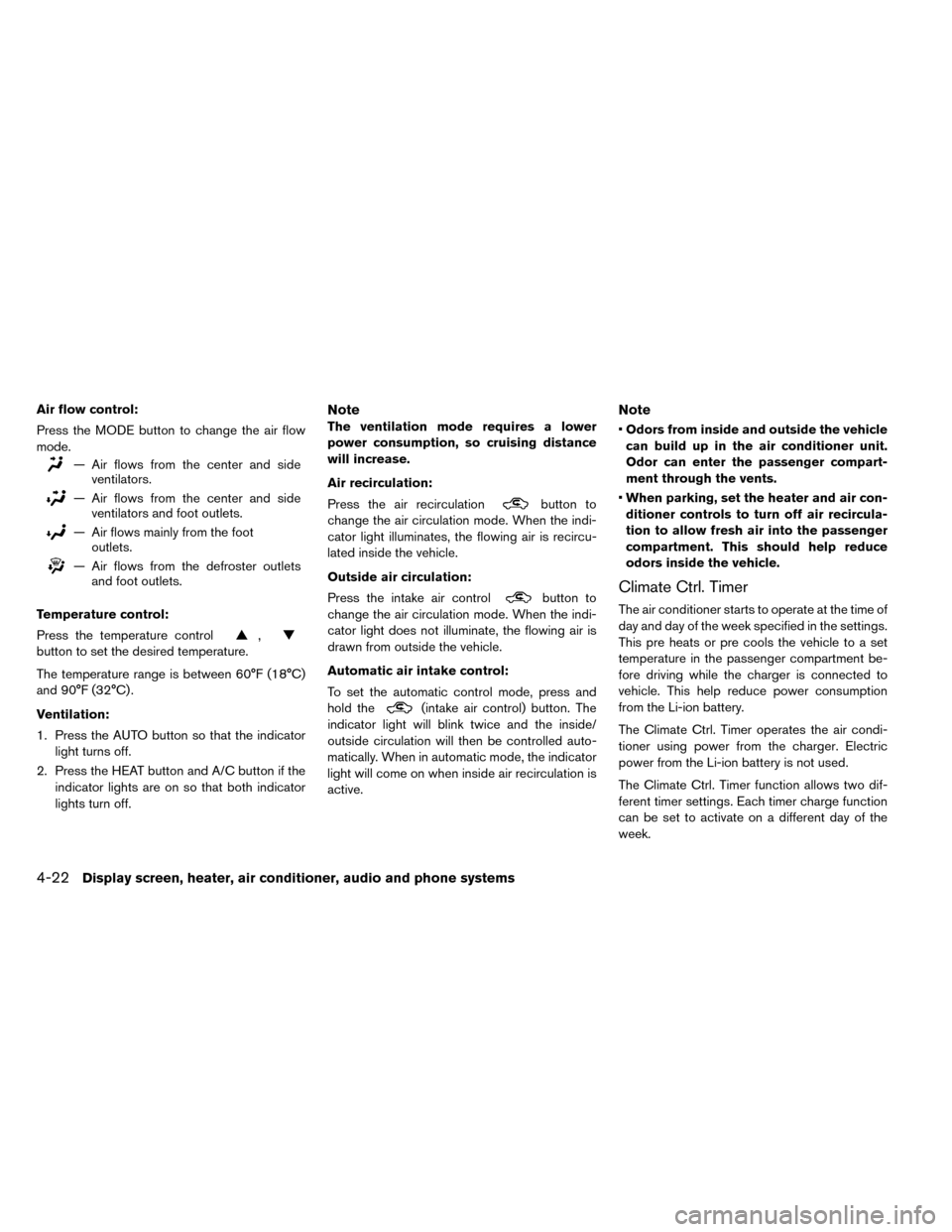
Air flow control:
Press the MODE button to change the air flow
mode.
— Air flows from the center and sideventilators.
— Air flows from the center and sideventilators and foot outlets.
— Air flows mainly from the footoutlets.
— Air flows from the defroster outletsand foot outlets.
Temperature control:
Press the temperature control
,
button to set the desired temperature.
The temperature range is between 60°F (18°C)
and 90°F (32°C) .
Ventilation:
1. Press the AUTO button so that the indicator light turns off.
2. Press the HEAT button and A/C button if the indicator lights are on so that both indicator
lights turn off.
Note
The ventilation mode requires a lower
power consumption, so cruising distance
will increase.
Air recirculation:
Press the air recirculation
button to
change the air circulation mode. When the indi-
cator light illuminates, the flowing air is recircu-
lated inside the vehicle.
Outside air circulation:
Press the intake air control
button to
change the air circulation mode. When the indi-
cator light does not illuminate, the flowing air is
drawn from outside the vehicle.
Automatic air intake control:
To set the automatic control mode, press and
hold the
(intake air control) button. The
indicator light will blink twice and the inside/
outside circulation will then be controlled auto-
matically. When in automatic mode, the indicator
light will come on when inside air recirculation is
active.
Note
• Odors from inside and outside the vehicle
can build up in the air conditioner unit.
Odor can enter the passenger compart-
ment through the vents.
• When parking, set the heater and air con-
ditioner controls to turn off air recircula-
tion to allow fresh air into the passenger
compartment. This should help reduce
odors inside the vehicle.
Climate Ctrl. Timer
The air conditioner starts to operate at the time of
day and day of the week specified in the settings.
This pre heats or pre cools the vehicle to a set
temperature in the passenger compartment be-
fore driving while the charger is connected to
vehicle. This help reduce power consumption
from the Li-ion battery.
The Climate Ctrl. Timer operates the air condi-
tioner using power from the charger. Electric
power from the Li-ion battery is not used.
The Climate Ctrl. Timer function allows two dif-
ferent timer settings. Each timer charge function
can be set to activate on a different day of the
week.
4-22Display screen, heater, air conditioner, audio and phone systems
Page 250 of 412
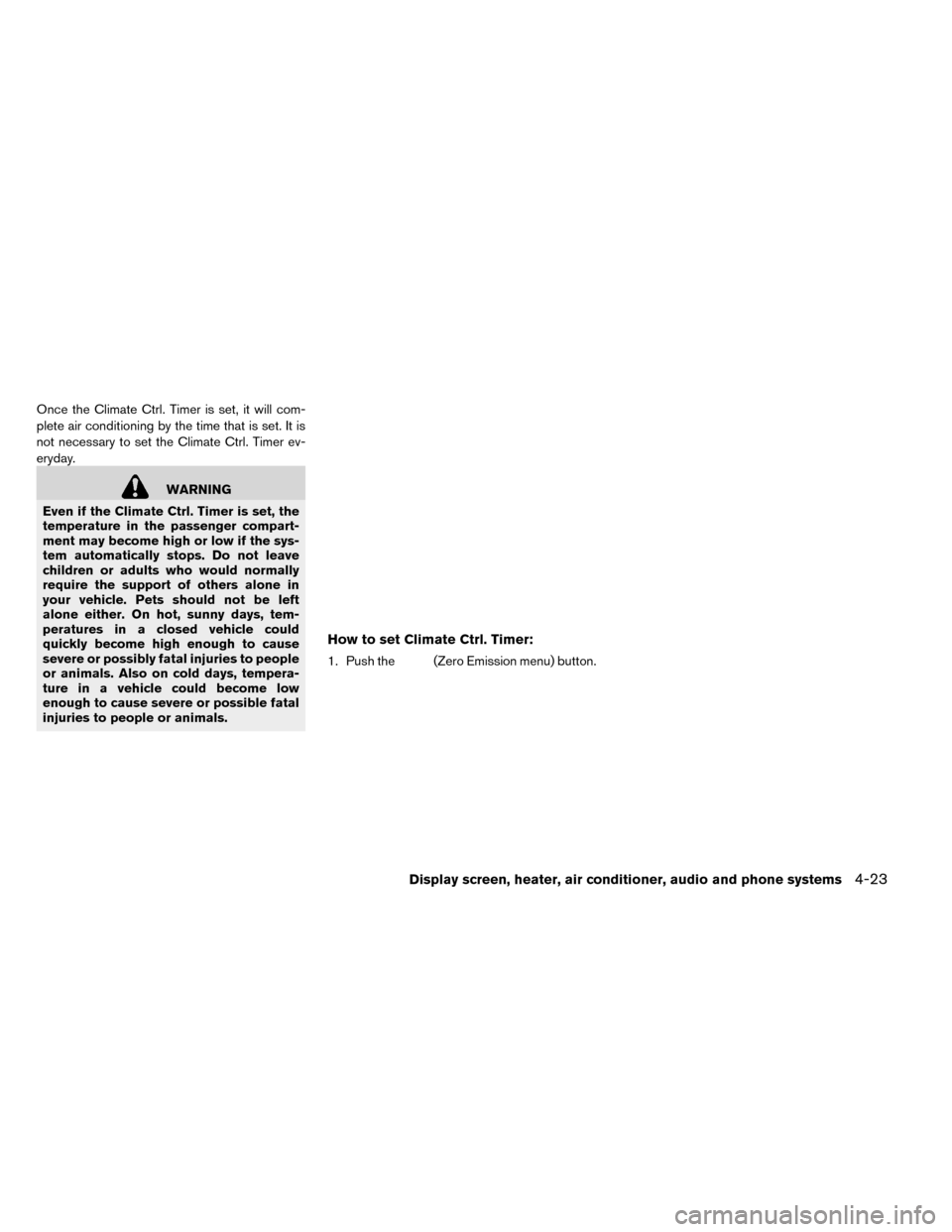
Once the Climate Ctrl. Timer is set, it will com-
plete air conditioning by the time that is set. It is
not necessary to set the Climate Ctrl. Timer ev-
eryday.
WARNING
Even if the Climate Ctrl. Timer is set, the
temperature in the passenger compart-
ment may become high or low if the sys-
tem automatically stops. Do not leave
children or adults who would normally
require the support of others alone in
your vehicle. Pets should not be left
alone either. On hot, sunny days, tem-
peratures in a closed vehicle could
quickly become high enough to cause
severe or possibly fatal injuries to people
or animals. Also on cold days, tempera-
ture in a vehicle could become low
enough to cause severe or possible fatal
injuries to people or animals.
How to set Climate Ctrl. Timer:
1. Push the(Zero Emission menu) button.
Display screen, heater, air conditioner, audio and phone systems4-23
Page 251 of 412
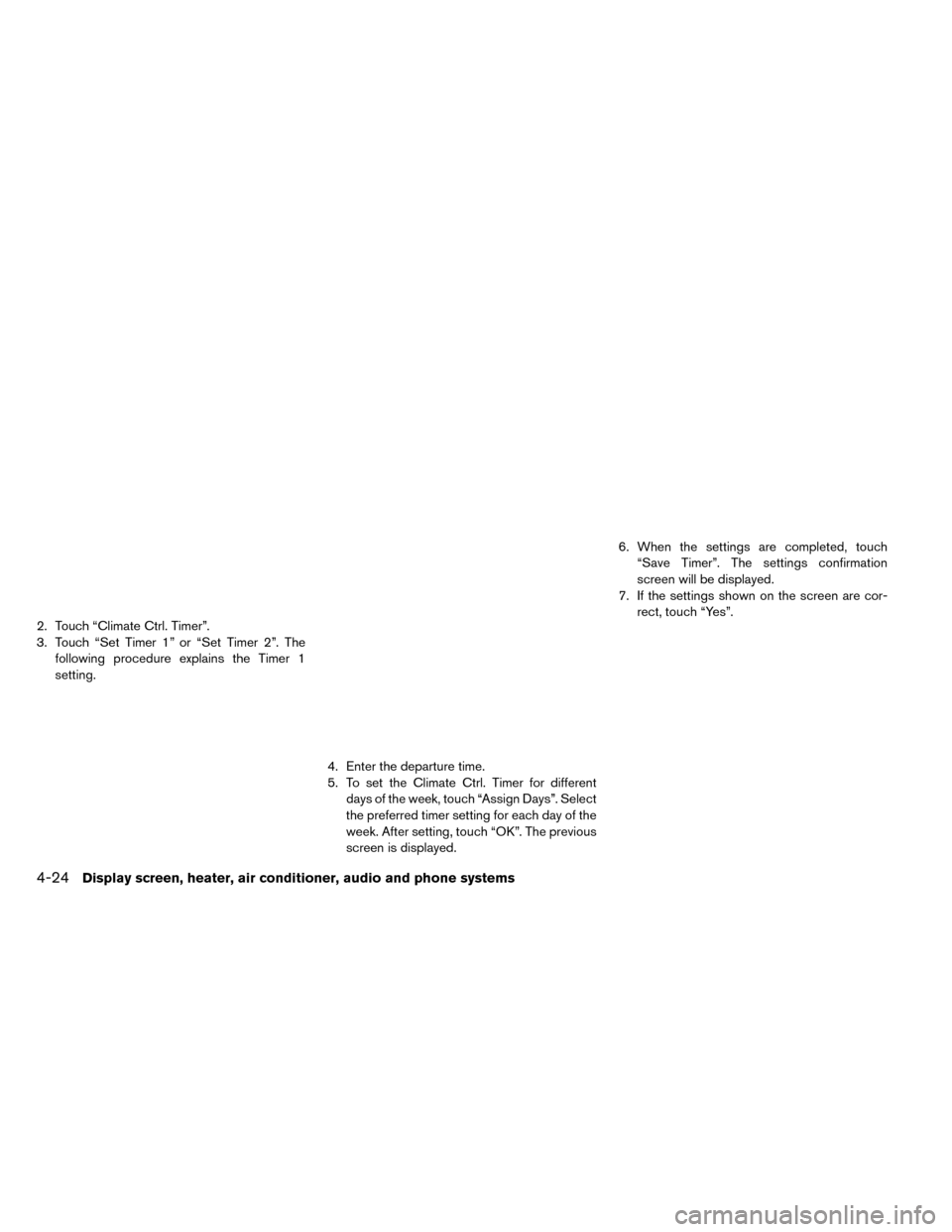
2. Touch “Climate Ctrl. Timer”.
3. Touch “Set Timer 1” or “Set Timer 2”. Thefollowing procedure explains the Timer 1
setting.
4. Enter the departure time.
5. To set the Climate Ctrl. Timer for differentdays of the week, touch “Assign Days”. Select
the preferred timer setting for each day of the
week. After setting, touch “OK”. The previous
screen is displayed. 6. When the settings are completed, touch
“Save Timer”. The settings confirmation
screen will be displayed.
7. If the settings shown on the screen are cor- rect, touch “Yes”.
4-24Display screen, heater, air conditioner, audio and phone systems
Page 252 of 412
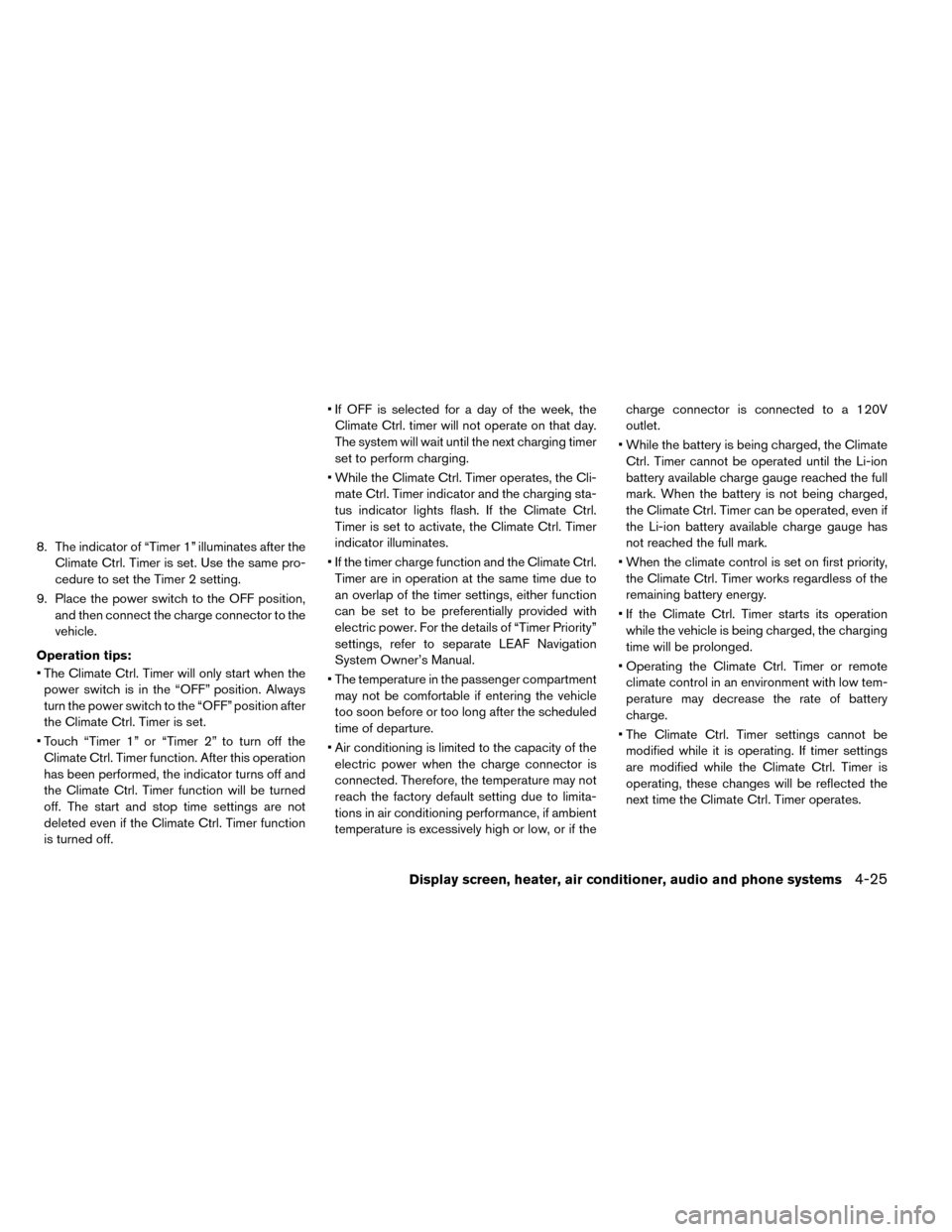
8. The indicator of “Timer 1” illuminates after theClimate Ctrl. Timer is set. Use the same pro-
cedure to set the Timer 2 setting.
9. Place the power switch to the OFF position, and then connect the charge connector to the
vehicle.
Operation tips:
• The Climate Ctrl. Timer will only start when the power switch is in the “OFF” position. Always
turn the power switch to the “OFF” position after
the Climate Ctrl. Timer is set.
• Touch “Timer 1” or “Timer 2” to turn off the Climate Ctrl. Timer function. After this operation
has been performed, the indicator turns off and
the Climate Ctrl. Timer function will be turned
off. The start and stop time settings are not
deleted even if the Climate Ctrl. Timer function
is turned off. • If OFF is selected for a day of the week, the
Climate Ctrl. timer will not operate on that day.
The system will wait until the next charging timer
set to perform charging.
• While the Climate Ctrl. Timer operates, the Cli- mate Ctrl. Timer indicator and the charging sta-
tus indicator lights flash. If the Climate Ctrl.
Timer is set to activate, the Climate Ctrl. Timer
indicator illuminates.
• If the timer charge function and the Climate Ctrl. Timer are in operation at the same time due to
an overlap of the timer settings, either function
can be set to be preferentially provided with
electric power. For the details of “Timer Priority”
settings, refer to separate LEAF Navigation
System Owner’s Manual.
• The temperature in the passenger compartment may not be comfortable if entering the vehicle
too soon before or too long after the scheduled
time of departure.
• Air conditioning is limited to the capacity of the electric power when the charge connector is
connected. Therefore, the temperature may not
reach the factory default setting due to limita-
tions in air conditioning performance, if ambient
temperature is excessively high or low, or if the charge connector is connected to a 120V
outlet.
• While the battery is being charged, the Climate Ctrl. Timer cannot be operated until the Li-ion
battery available charge gauge reached the full
mark. When the battery is not being charged,
the Climate Ctrl. Timer can be operated, even if
the Li-ion battery available charge gauge has
not reached the full mark.
• When the climate control is set on first priority, the Climate Ctrl. Timer works regardless of the
remaining battery energy.
• If the Climate Ctrl. Timer starts its operation while the vehicle is being charged, the charging
time will be prolonged.
• Operating the Climate Ctrl. Timer or remote climate control in an environment with low tem-
perature may decrease the rate of battery
charge.
• The Climate Ctrl. Timer settings cannot be modified while it is operating. If timer settings
are modified while the Climate Ctrl. Timer is
operating, these changes will be reflected the
next time the Climate Ctrl. Timer operates.
Display screen, heater, air conditioner, audio and phone systems4-25
Page 253 of 412
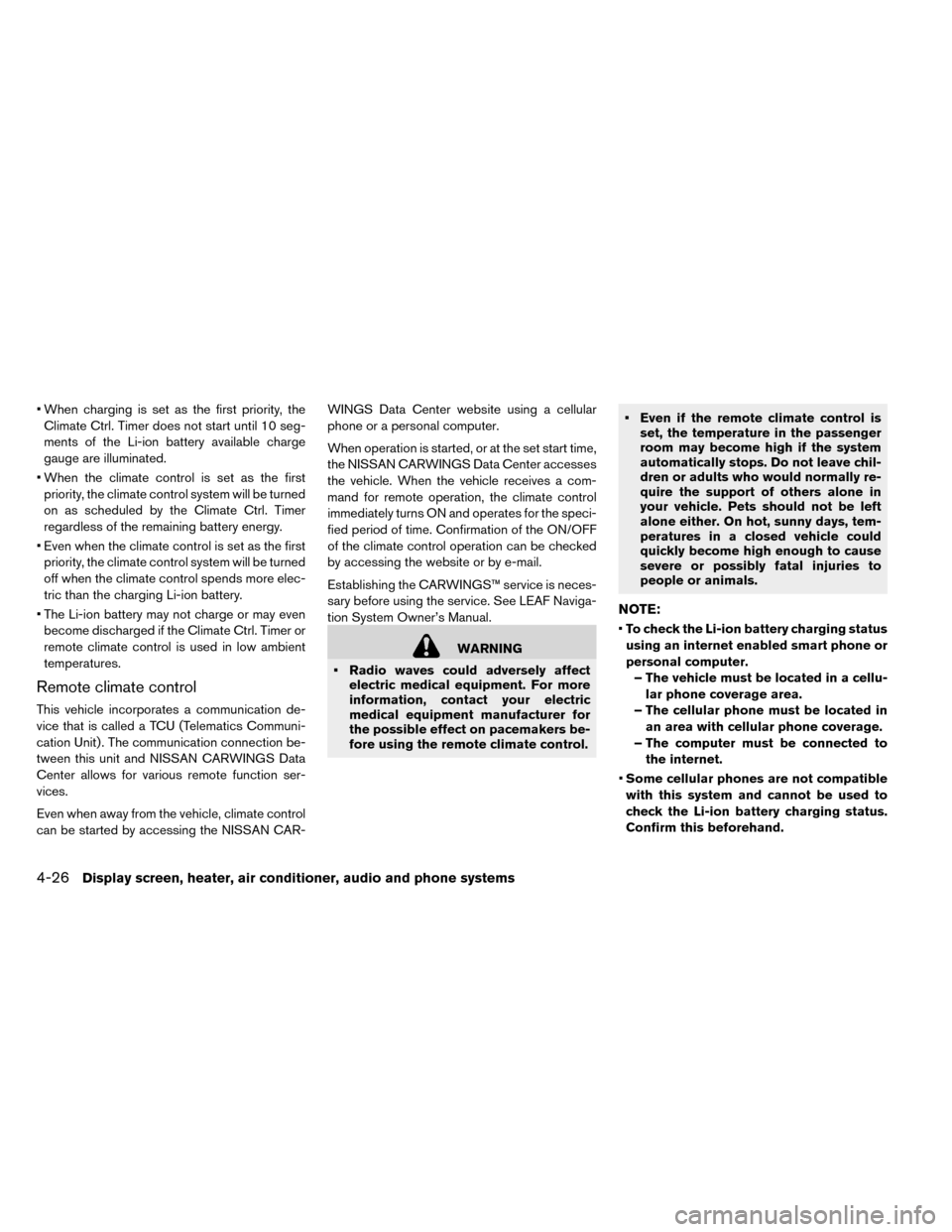
• When charging is set as the first priority, theClimate Ctrl. Timer does not start until 10 seg-
ments of the Li-ion battery available charge
gauge are illuminated.
• When the climate control is set as the first priority, the climate control system will be turned
on as scheduled by the Climate Ctrl. Timer
regardless of the remaining battery energy.
• Even when the climate control is set as the first priority, the climate control system will be turned
off when the climate control spends more elec-
tric than the charging Li-ion battery.
• The Li-ion battery may not charge or may even become discharged if the Climate Ctrl. Timer or
remote climate control is used in low ambient
temperatures.
Remote climate control
This vehicle incorporates a communication de-
vice that is called a TCU (Telematics Communi-
cation Unit) . The communication connection be-
tween this unit and NISSAN CARWINGS Data
Center allows for various remote function ser-
vices.
Even when away from the vehicle, climate control
can be started by accessing the NISSAN CAR- WINGS Data Center website using a cellular
phone or a personal computer.
When operation is started, or at the set start time,
the NISSAN CARWINGS Data Center accesses
the vehicle. When the vehicle receives a com-
mand for remote operation, the climate control
immediately turns ON and operates for the speci-
fied period of time. Confirmation of the ON/OFF
of the climate control operation can be checked
by accessing the website or by e-mail.
Establishing the CARWINGS™ service is neces-
sary before using the service. See LEAF Naviga-
tion System Owner’s Manual.
WARNING
• Radio waves could adversely affect electric medical equipment. For more
information, contact your electric
medical equipment manufacturer for
the possible effect on pacemakers be-
fore using the remote climate control. • Even if the remote climate control is
set, the temperature in the passenger
room may become high if the system
automatically stops. Do not leave chil-
dren or adults who would normally re-
quire the support of others alone in
your vehicle. Pets should not be left
alone either. On hot, sunny days, tem-
peratures in a closed vehicle could
quickly become high enough to cause
severe or possibly fatal injuries to
people or animals.
NOTE:
•To check the Li-ion battery charging status
using an internet enabled smart phone or
personal computer.
– The vehicle must be located in a cellu- lar phone coverage area.
– The cellular phone must be located in an area with cellular phone coverage.
– The computer must be connected to the internet.
• Some cellular phones are not compatible
with this system and cannot be used to
check the Li-ion battery charging status.
Confirm this beforehand.
4-26Display screen, heater, air conditioner, audio and phone systems
Page 254 of 412
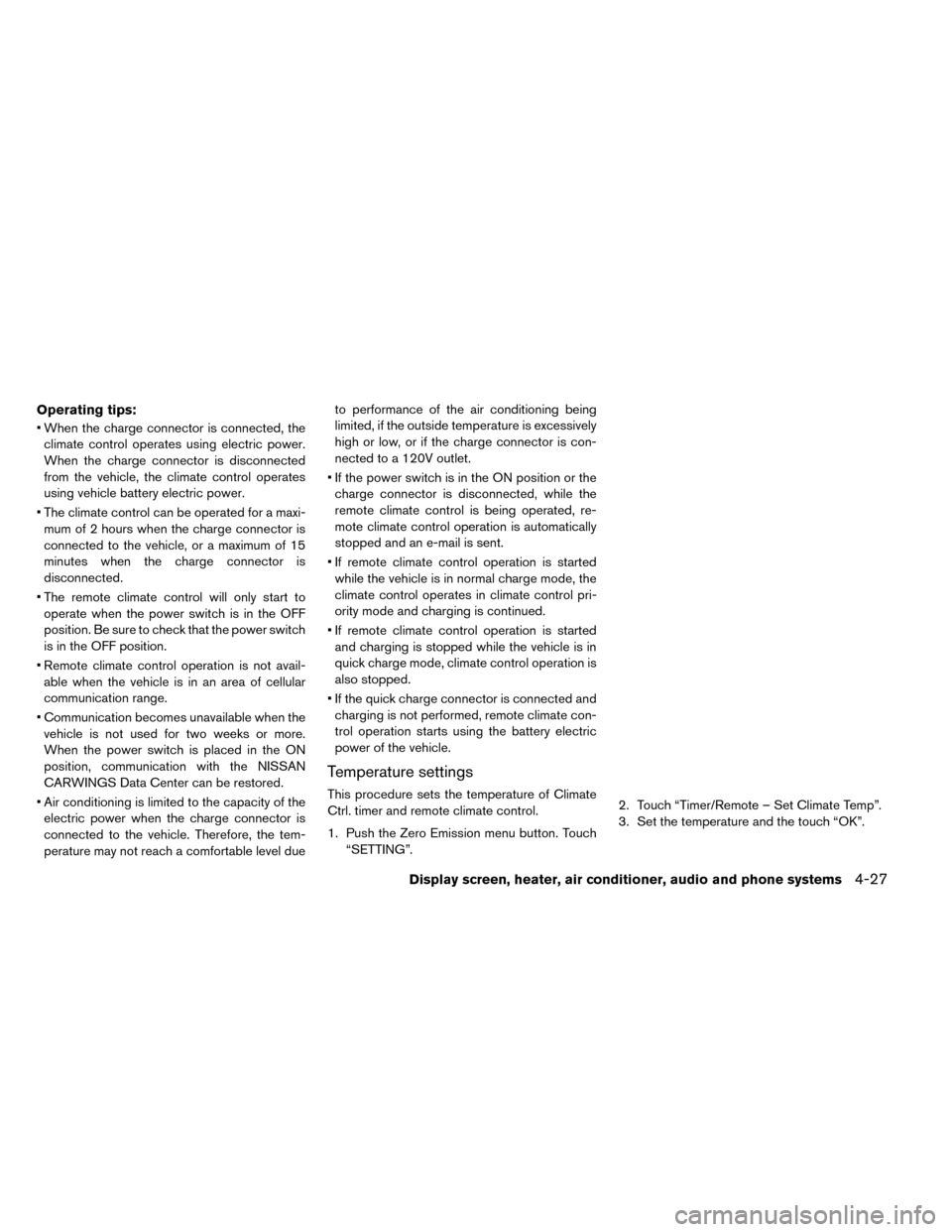
Operating tips:
• When the charge connector is connected, theclimate control operates using electric power.
When the charge connector is disconnected
from the vehicle, the climate control operates
using vehicle battery electric power.
• The climate control can be operated for a maxi- mum of 2 hours when the charge connector is
connected to the vehicle, or a maximum of 15
minutes when the charge connector is
disconnected.
• The remote climate control will only start to operate when the power switch is in the OFF
position. Be sure to check that the power switch
is in the OFF position.
• Remote climate control operation is not avail- able when the vehicle is in an area of cellular
communication range.
• Communication becomes unavailable when the vehicle is not used for two weeks or more.
When the power switch is placed in the ON
position, communication with the NISSAN
CARWINGS Data Center can be restored.
• Air conditioning is limited to the capacity of the electric power when the charge connector is
connected to the vehicle. Therefore, the tem-
perature may not reach a comfortable level due to performance of the air conditioning being
limited, if the outside temperature is excessively
high or low, or if the charge connector is con-
nected to a 120V outlet.
• If the power switch is in the ON position or the charge connector is disconnected, while the
remote climate control is being operated, re-
mote climate control operation is automatically
stopped and an e-mail is sent.
• If remote climate control operation is started while the vehicle is in normal charge mode, the
climate control operates in climate control pri-
ority mode and charging is continued.
• If remote climate control operation is started and charging is stopped while the vehicle is in
quick charge mode, climate control operation is
also stopped.
• If the quick charge connector is connected and charging is not performed, remote climate con-
trol operation starts using the battery electric
power of the vehicle.
Temperature settings
This procedure sets the temperature of Climate
Ctrl. timer and remote climate control.
1. Push the Zero Emission menu button. Touch “SETTING”. 2. Touch “Timer/Remote – Set Climate Temp”.
3. Set the temperature and the touch “OK”.
Display screen, heater, air conditioner, audio and phone systems4-27